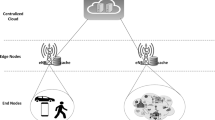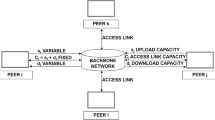Abstract
Periodic broadcasting is one of the cost-effective solutions for distributing popular videos to clients under constant worst playback latency. The broadcasting methods typically transmit video segments across multiple channels simultaneously, thus, requiring a client to receive segments from these channels concurrently. However, numerous practical systems, such as digital video broadcasting-handheld (DVB-H), do not allow clients to download video data from multiple channels because clients usually only have one tuner. To resolve this problem in multiple-channel broadcasting, the alternative broadcasting (AB) scheme, the hopping insertion (HI) scheme, SingBroad, PAS, the reverse-order scheduling (ROS) scheme, and the half-division broadcasting (HDB) scheme have been proposed to broadcast segments over a single channel. This paper presents a novel single-channel broadcasting scheme, which partitions a video into segments as many as possible to reduce video playback latency. Using mathematical analysis, this study verifies the workability of this scheme by demonstrating that client playback continuity is guaranteed. A performance analysis indicates that the proposed scheme yields the smallest waiting time, when compared with AB, HI, SingBroad, PAS, ROS, and HDB under various parameter settings. In addition, comprehensive simulation results show that the proposed scheme and ROS outperform these schemes (The comparison does not include the HI scheme because its buffer requirements are not provided in [24]) regarding smaller client buffer requirements under larger broadcasting bandwidth settings.







Similar content being viewed by others
References
Chand S, Om H (2010) Efficient staircase scheme with seamless channel transition mechanism. Comput Netw 54:462–474
Chen Y-W, Chen C-Y (2011) PAS: A new scheduling scheme for broadcasting a video over a single channel. IET Commun 5(7):951–960
Chen YW, Hsieh CY (2009) Sing broad: A scheduling scheme for broadcasting continuous multimedia data over a single channel. Comput Netw 53(9):1546–1554
Chen Y-W, Lin C-C, Huang C-Y (2012) Hybrid broadcasting scheme with low waiting time and buffer requirement for video-on-demand services. IET Commun 6(17):2949–2956
Chen Y-N, Tseng L-M (2012) An efficient periodic broadcasting with small latency and buffer demand for near video on demand., International Journal of Digital Multimedia Broadcasting 717538: 7
Chien W-D, Yeh Y-S, Wang J-S (September 2005) Practical channel transition for near-VOD services. IEEE Trans Broadcast 51(3):360–365
Choi J, Reaz A, Mukherjee B (2012) A survey of user behavior in VoD service and bandwidth-saving multicast streaming schemes. IEEE Communications Surveys and Tutorials 14(1):156–169
Chung Y (2011) A speculative load adaptive streaming scheme for efficient video delivery. Multimedia Systems 17(3):165–176
Digital TV Research (2012) A sustained boom forecast for global online TV and video
Febiansyah H, Kwon JB (2012) Dynamic proxy-assisted scalable broadcasting of videos for heterogeneous environments. Multimedia Tools and Applications
Juhn L-S, Tseng L-M (1997) Harmonic broadcasting for video-on-demand service. IEEE Trans Broadcast 43(3):268–271
Juhn L-S, Tseng L-M (November 1997) Staircase data broadcasting and receiving scheme for hot video service. IEEE Trans Consum Electron 43(4):1110–1117
Tang W, Fu Y, Cherkasova L, Vahdat A (January 2007) Modeling and generating realistic streaming media server workloads. Comput Netw 51(1):336–356
TechNavio (2012) Global video on demand market 2011–2015
Tseng Y-C, Chueh Y-C, Sheu J-P (2004) Seamless channel transition for the staircase video broadcasting scheme. IEEE/ACM Trans Networking 12(3):559–571
Tseng Y-C, Yang M-H, Chang C-H (2002) A recursive frequency-splitting scheme for broadcasting hot videos in VOD service. IEEE Trans Commun 50(8):1348–1355
Tseng Y-C, Yang M-H, Hsieh C-M, Liao W-H, Sheu J-P (2001) Data broadcasting and seamless channel transition for highly demanded videos. IEEE Trans Commun 49(5):863–874
Van der Auwera G, Reisslein M (2009) Implications of smoothing on statistical multiplexing of H.264/AVC and SVC video streams. IEEE Trans Broadcast 55(3):541–558
Vilas M, Paneda XG, Garcia R, Melendi D, Garcia VG (2005) User behavior analysis of a video-on-demand service with a wide variety of subjects and lengths. In. Proceedings of the 31st EUROMICRO Conference on Software Engineering and Advanced Applications 330–337
Wu B-S, Hsieh C-C, Chen Y-W (September 2011) A reverse-order scheduling scheme for broadcasting continuous multimedia data over a single channel. IEEE Trans Broadcast 57(3):721–728
Yang Z-Y, Chen Y-M, Tseng L-M (2012) A seamless broadcasting scheme with live video support. International Journal of Digital Multimedia Broadcasting 373459:8
Yoshihisa T, Nishio S (March 2013) A division-based broadcasting method considering channel bandwidths for NVoD services. IEEE Trans Broadcast 59(1):62–71
Yoshihisa T, Tsukamoto M, Nishio S (March 2006) A scheduling scheme for continuous media data broadcasting with a single channel. IEEE Trans Broadcast 52(1):1–10
Yoshihisa T, Tsukamoto M, Nishio S (September 2007) A broadcasting scheme considering units to play continuous media data. IEEE Trans Broadcast 53(3):628–636
Yu H-F (2008) Hybrid broadcasting with small buffer demand and waiting time for video-on-demand applications. IEEE Trans Broadcast 54(2):304–311
Yu H-F (2013) Extension of practical channel transition broadcasting for near video-on-demand applications. Multimedia Tools and Applications
Yu H-F (2013) Single-channel data broadcasting under small waiting latency. J Appl Math 629350: 8
Yu H-F, Yang H-C, Tseng L-M (March 2007) Reverse fast broadcasting (RFB) for video-on-demand applications. IEEE Trans Broadcast 53(1):103–111
Yu H, Zheng D, Zhao BY, Zheng W (2006) Understanding user behavior in large-scale video-on-demand systems. Proceedings of EuroSys 2006:333–344
Acknowledgments
This work was financially supported by National Science Council, Taiwan under a research grant numbered NSC 102-2221-E-152-003.
Author information
Authors and Affiliations
Corresponding author
Rights and permissions
About this article
Cite this article
Yu, HF. Efficient periodic broadcasting scheme for video delivery over a single channel. Multimed Tools Appl 74, 5811–5824 (2015). https://doi.org/10.1007/s11042-014-1889-2
Published:
Issue Date:
DOI: https://doi.org/10.1007/s11042-014-1889-2




